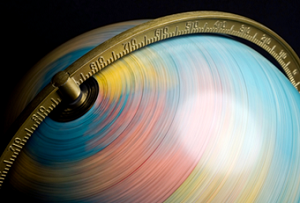29 July 2022: Shortest Day on Earth
- 02 Aug 2022
On July 29, the Earth broke its record for the shortest day as it completed a full spin in 1.59 milliseconds less than its standard 24-hour rotation.
Earlier, in 2020, the Earth saw its shortest month that has ever been recorded since the 1960s. On July 19 of that year, the shortest of all time was measured. It was 1.47 milliseconds shorter than a typical 24-hour day.

(Image Source: interestingengineering.com)
Possible Causes of Differing Speed of Earth's Spin
- The cause of the differing speed of Earth's spin is still unknown.
- Scientists speculate that this could be because of processes in the inner or outer layers of the core, oceans, tides or even changes in climate.
- Some researchers also believe that this could be related to the movement of Earth's geographic poles across its surface, known as the "Chandler wobble".
Impact of Quick Spin of the Earth
- Earth's faster rotation has an impact on us. It is because atomic clocks which are used in GPS satellites don't consider the Earth's changing rotation in its calculation. That means, in case Earth spins faster, then it will get the same position a little earlier. "A half-a-millisecond equates to 10-inches or 26 centimeters at the equator. In short, GPS satellites—which already have to be corrected for the effect of Einstein's Theory of Relativity (the curve of space and time)— is quickly becoming useless".
- This may also confuse smartphones, computers, and communications systems, which are based on Network Time Protocol (NTP) servers, defined as the number of seconds since 00:00:00 UTC on January 1, 1970.
Possible Remedy: Adding Negative Leap Seconds
- To resolve the confusion, scientists may need to add negative leap seconds, which basically means a drop second.
Problem with Negative Leap Seconds
- If the Earth continues to spin at an increasing rate it could lead to the introduction of the negative leap seconds, in a bid to keep the rate that the Earth orbits the Sun consistent with the measurement from atomic clocks.
- However, the negative leap second would have potentially confusing consequences for smartphones, computers and communications systems.
- The leap second mainly benefits scientists and astronomers but is a risky practice that does more harm than good. This is because the clock progresses from 23:59:59 to 23:59:60 before resetting to 00:00:00. A time jump like this can, therefore, crash programmes and corrupt data due to the timestamps on the data storage.
- If a negative leap second occurs, the clock will change from 23:59:58 to 00:00:00, and this could have a "devastating effect" on the software relying on timers and schedulers. To solve this, international timekeepers may need to add a negative leap second - a "drop second".
Notably, Coordinated Universal Time (UTC), the primary time standard by which the world regulates clocks and time, has already been updated with a leap second 27 times.




